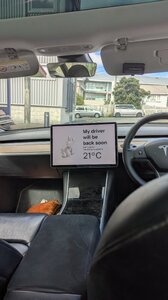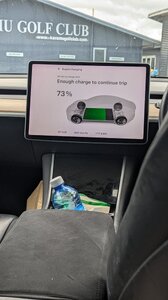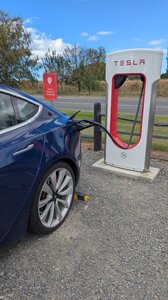
octave
Members-
Posts
3,931 -
Joined
-
Last visited
-
Days Won
40
Content Type
Profiles
Forums
Gallery
Downloads
Blogs
Events
Our Shop
Movies
Everything posted by octave
-
Red, that sounds correct. The Tesla network is easier because it requires no apps, you register the car and the charger knows which car is being charged. I saw a YouTube clip this morning about Norway. They have had, I think for about a year now, a law that says all new chargers must have a card reader or tap and go facility. This avoids the need for apps. In NZ I have noticed that there are loads of petrol stations that are unstaffed. These stations, which appear in towns and out in the sticks, are just like a normal petrol station minus the building. In other words just the pumps and an awning. You swipe your credit or debit card, put the fuel in and then it spits a receipt out. I think one of the reasons this is not more widespread in this country is that petrol stations want to get you inside so you might buy other items.
-
We did exactly this. We were in an air BnB. My son rang the owner and asked if they minded us charging overnight. They were fine with but this was a granny lead maximum 10 AMPs this is not a problem compared to running a heater all night. Using a standard PowerPoint imposes limits. Motels sometimes have proper chargers that do use larger quantities of power. These are a business decision, and either it is a third-party installation in which case I suspect they take a cut of the profit or they supply it to attract customers. I don't really care whether people here want to buy an EV or not. I won't buy one until my present car dies, it is simply not economically viable given the few km I drive. I do think people tend to come up with a multitude of reasons why they are unviable; often, these reasons are not based on real-world experience. Likewise, it is easy for enthusiasts to not understand to downsides. This is why I posted my original post (which I regret now)
-
That is not quite correct. My point was that whenever we needed to stop for the toilet or food we also took the opportunity to stick a bit of charge in. It always not a case of wondering around blindly hoping to stumble on a charger. The route planner gave numerous options along with co located facilities such as food or toilets etc. We stopped twice in 4 hours one of these was to buy supplies and coffee and the second for tor a toilet break. This at least for me was little different from a petrol driven trip I posted of an account of the trip because I thought it would add some useful input.
-
Onetrack that does seem a little paranoid. My electricity bill comes straight out of my account as does my internet. I can assure you that I am astute enough to monitor these things. The car keeps a record of electricity purchased. It is not true that you can own it charge a Tesla without a credit card.
-
Just another thought on battery swapping. My son has a Tesla 3, and his girlfriend has a BYD Atto 3. These vehicles have different battery chemistries and, of course, are physically different in terms of size, weight, attachment methods, etc. In order for battery swapping to be the common way, there needs to be standardisation. As well as being a complex task for every manufacturer to use the same standard, there is also the problem that this could stifle progress. If a battery has to be in a specific location. What if a manufacturer wanted for reasons of handling and weight distribution, to put some of the batteries in the front and some in the back? Whilst battery swapping in optimal cases can be done in a few minutes, EVS are also getting much quicker to charge. As they do get quicker, the case for battery swap will diminish.
-
Can I ask if this is a researched assertion, or is it your gut feeling? My post, which was intended as part of a debate. I was talking about NZ. I don't have practical experience of travelling around Australia. I know there are EV drivers who have travelled around Australia. If your argument is that we should be rolling out more infrastructure, then I am in agreement with you. Although I had no particular point to make with my initial post, if I were to make a point, it would be that we are lagging behind other countries. Whilst I believe battery swapping may be part of the solution, especially for larger commercial vehicles, I don't believe that they are the main solution. If you believe we can't build a charging network quickly enough, what makes you think we can build a battery swapping network (including remote) quickly enough? How does a remote battery swap centre ensure an adequate supply of batteries? If I swap a battery in the middle of the Nullabor Plain, I would presumably swap it again at another swap centre many miles away. How does the remote swap centre maintain a stock of batteries when people are taking them away and not bringing them back? Sure other people coming the other way might be dropping off batteries but it would be a bit of a balancing act. The solution to having enough chargers is to build them, not to avoid EVS. Interestingly, when you actually have a look at charging centres, they are often provided by private businesses. We use one at a Westfield shopping mall car park. Why was it there? Well, we went inside and bought some food. The charging centre at the golf club I assume, utilises some of their carpark and presumably gets a share of the revenues, and I suppose it benefits their members who drive EVs. Whilst in NZ we got a bus from Christchurch Airport into the City. Many of the buses are electric, and all of the airport buses are EV. They can drive around the city all day and they charge over 2 hours at night. Electric buses – all you need to know
-
I can say that NZ is way ahead in terms of EV adoption. Charging facilities are everywhere there are not queues to use them anymore than there are queues for petrol stations. Yes if everyone suddenly bought an EV overnight then there might be a temporary problem. I am sure back when Henry Ford started producing the Model T, people might have worried that there would not be enough petrol refuelling points. Countries like Norway seem to cope with a much higher percentage of EVs than either Australia or NZ. Fun fact In a significant milestone for the state, California now has 48% more public and shared private EV chargers than the number of gasoline nozzles. California Energy Commission (CEC) estimates there are about 120,000 gas nozzles in the state, compared to 178,000 public and shared private chargers. Your question, "what about when EVs are the majority," seems to presuppose that the number of petrol or electricity refuelling points is not driven by demand. In Australia, the majority of new cars are petrol at this point. I haven't checked this figure, but I would imagine that this year there are more petrol cars on the road than last year. OMG what will happen when there aren't enough petrol stations? Of course, demand creates supply. I wasn't really expecting my post to "fuel" a debate; I just thought practical experience was of interest.
-
I thought I would give a quick review of some practical EV experience. As an EV enthusiast who doesn't own an EV, I can only go on what others tell me, but in this case, this is first-hand experience. We have just arrived back from a 3-week trip in NZ, visiting our "favourite" offspring (he is an only child). We spent a week driving around the South Island in petrol-driven rental cars. I have often been told by the anti EV crowd that it takes forever and it is impractical to go outside of the city coz it take a fortnight to charge - Bollocks! From my son's home we departed with around 90 something per cent charge. This was from his overnight charging, which due to a deal from the electricity company (they have to much power overnight, I think they sell it for about 10 cents a KWh). This electricity is generated from hydro. We had to make a stop in town because son and business partner had to pick up some merch to flog at the races. Mrs Octave and I opted to stay in the car rather than to go with them. Although it was not super hot, the sun was quite strong, so my son put the car into "dog mode", which kept the aircon running. Actually I am pretty sure you can do this some other way, but I think he thought "dog mod was humorous" We then drove for another hour and stopped at a supermarket which had a Tesla supercharger in the car park. He plugged it in and because it was a Tesla charger, there is no need to muck around with apps or credit cards, just plug it in and it charges the car and your credit card. From memory, the car was around 85ish %. We went into the supermarket to buy some nibbles for the journey and then located a cafe for the caffeine requirements. We probably would have been about 30 minutes. When we returned to the car, it was at 100%. We drove for a couple of hours and then needed to stop for a toilet break. We stopped at a Tesla supercharging site, plugged in and by the time we had all relieved ourselves, the Tesla was back to 100% ( charges about 280km per 15 minutes in ideal conditions). When we reached our destination, the power was down around the 20% level. The car directed us to a Tesla charger, and we plugged in and went to find somewhere for dinner. We found a pub with a rooftop dining area overlooking the lake. My son had one drink and then went to retrieve the car as it was approaching full. You can just leave it, but it is bad etiquette to leave a fully charged car taking up a charging spot. The next day the car was not needed by my son, so Mrs Octave and I went on a bit of a jaunt in it. We got back with 85% left. The car was plugged into the power point supplied by our accommodation with a 10 amp "granny lead" Next morning car at 100%. We drove from Taupo to Napier and stopped for a late breakfast. I was assuming the car would have been charged whilst we went to breakfast but this was not necessary. We later had a toilet stop at a golf club where the car was charged for a few minutes. A couple of hours later, we stopped at a town whose name I can't recall. We drove into a shopping mall car park and plugged the car into the Tesla charger whilst we went in search of more caffeine. I don't recall how much charge this gave us, but it took us the rest of the way home. It seems to me that at least with this car and in NZ, which is possibly ahead with charging infrastructure, road trips are incredibly easy. Now I imagine someone is going to say that in Australia we have much longer distances, and this is true. This is somewhat balanced out by the stupidly steep terrain in NZ and my son's shall we say, "enthusiastic" driving style.
-
You missed out Bi. I will take a doctor of any gender.
-
My doctor's sexual orientation is of little concern to me.
-
No my biggest fear is my carefully invested super that I rely on to live getting pissed away by this total moron. Super performance is closely linked with the stick market. Who benefits from crashing the market, those multi-million airs who can buy on the dip and make a fortune when the market improves temporarily.
-
Here is a site that can answer your questions https://www.solarquotes.com.au/
-
According to the interwebs. Does my electricity bill have to be above a certain amount to qualify for solar rebates? "your electricity bill amount doesn't determine eligibility for the Australian solar rebate, which is based on the size and type of the solar system installed, not your electricity consumption."
-
I honestly think this is not correct. I have been looking through the latest information on the "solar quotes" site and I can not find anything that would preclude you from getting it. As I say contact a reputable installer and ask. The rebate system can be a little complex but they will soon tell you if you qualify or not.
-
I would agree that you must consider the payback time. If you can run your welder and AC and still have bills under $250 a quarter I would suggest that solar is if no benefit to you.
-
By the way I can't find any reference to the $250 figure for solar rebates. When we got our solar there were 2 incentives. One was a state government interest free loan. Then there are STCs (small scale technology certificates. There may have been another rebate, I can't quite remember. Anyway the point is if you are genuinely wanting to get solar then just find a reputable installer, give them a ring, explain you circumstance and they will soon let you know what subsidies you would qualify for.
-
Are you sure about that. It may be worth rechecking, these subsidies change from time to time. If your bill is only just under this sum can't you just leave the oven on for a couple of hours a day? If your bill is that low then it is probably not worth getting solar anyway. With your low power bills the solar may never pay for itself.
-
My advice is if you are really serious about getting solar look for online reviews and choose a company with a good reputation. Then contact only that company That is what we did and it turned out fine. If you are not that serious then just forget it and move on. It sounds like your bills are not that high anyway.
-
We had a great experience with our solar installer. We did of course a lot of research as to which were the best installers in our area. They came out and inspected the site and suggested a system. Far from them trying to upsell they actually did the opposite. We were keen to also get a battery however the solar guy did the figures and told us that at that point in time a battery would not have been economically smart. He said he would be happy to install one if we really wanted them. Since installation (6years) we have had 2 faults. A micro inverter on one panel failed. This meant our power production was down by one panel. This was fixed within a week under warranty. The other problem was a failure cons to the bet. This meant that our power to the grid was still working but we just couldn't monitor on our app. This was also fixed under warranty. The thing is you just have to do your research. Solar company websites ask your address because at least here in Vic not all suburbs qualified for subsidies, it depends on the requirements of the local grid. The process was slightly complicated however the installer did most of the admin. The application for the various subsidies was a bit of a pain but worth it. My advice to anyone wanting to get solar is like with any large purchase you just have to do your homework. When a system is installed it has to be inspected by an independent inspector. Our inspector just had a quick look around and said this company always does good quality installations.
-
https://gosolarquotes.com.au/free-solar-panels/pensioners-low-income-household-scheme-nsw/#:~:text=Eligible pensioners and low-income,system installed on their homes.
-
https://techau.com.au/channel-7s-spotlight-on-evs-fails-to-identify-any-ev-maker-that-actually-uses-dirty-nickel-from-indonesia/#google_vignette
-
Australia makes a good over the horizon radar that Canada wants to buy. We are also good at making wine that people seem to want to buy. I can only see this as a good thing. Protectionism comes at a cost, sometimes the cost may be worth it and often not. The car industry was kept afloat by the tax payers. The world is more interconnected than ever and I believe this is a good thing. It is much harder to imagine a world war given the economic dependence between countries and people.
-
I think there should certainly be rules about dangerous good or goods produced with slave labour or poor worker conditions. When it comes to quality I don't always need a top quality product. I renovated my bathroom and bought a budget tile saw for around $100. Sure although it did the job well it certainly wouldn't suit a tradie. I appreciate not having to pay many hundreds of dollars. I think the fact is that the world is only getting more connected and I think this is a good thing
-
I think there are obviously pros and cons. We have all come to expect that a car won't cost many years wages to buy. I recall when I was young my family saving up for a considerable time to buy a new television. I do think a lot of people complain about things being made overseas where labour is cheaper but will also whinge prices going up. We want our products to be sold overseas but tend to complain when tools or electronics are made in China








